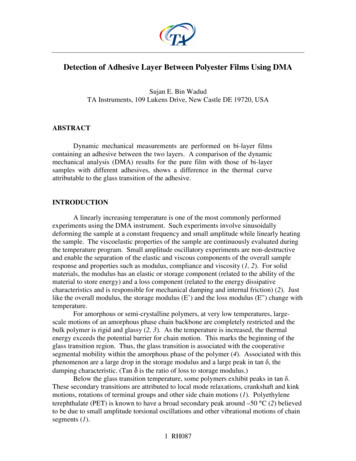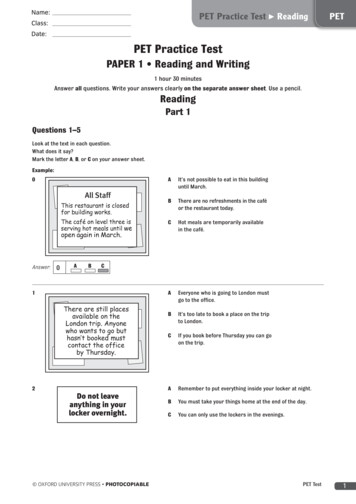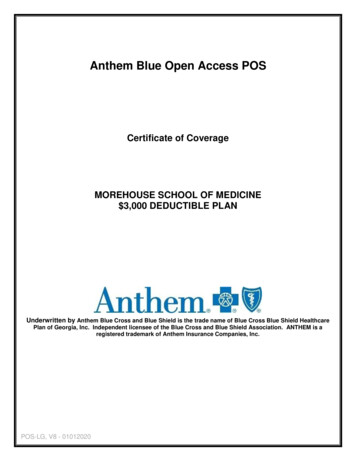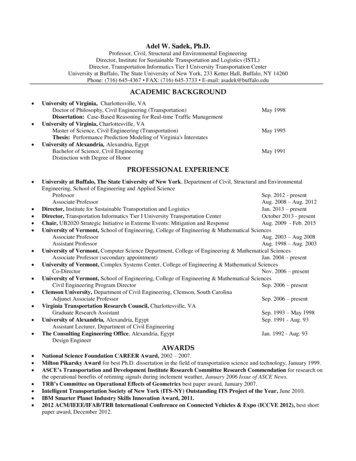
Transcription
ProspectusBlue Buffalo Pet Products, Inc.15,000,000 sharesThe selling stockholders are selling 15,000,000 shares of common stock. We will not be selling any shares in thisoffering and will not receive any proceeds from the sale of shares by the selling stockholders.Our common stock is listed on the NASDAQ Global Select Market, or NASDAQ, under the symbol “BUFF.”The last reported sale price of our common stock on the NASDAQ on June 24, 2016 was 24.03 per share.Per sharePublic offering price . . . . . . . . . . . . . . . . . . . . . . . . . . . . . . . . . . . . . . . . . . . . . . . . . . . . . 22.000Underwriting discounts and commissions(1) . . . . . . . . . . . . . . . . . . . . . . . . . . . . . . . . . . 0.715Proceeds to the selling stockholders, before expenses . . . . . . . . . . . . . . . . . . . . . . . . . . . 21.285(1)Total 330,000,000 10,725,000 319,275,000See “Underwriting.”The selling stockholders have granted the underwriters a 30-day option to purchase up to an additional2,250,000 shares of common stock.Investing in our common stock involves a high degree of risk. See “Risk Factors” beginning onpage 17.Neither the Securities and Exchange Commission nor any state securities commission hasapproved or disapproved of these securities or determined if this prospectus is truthful orcomplete. Any representation to the contrary is a criminal offense.The underwriters expect to deliver the shares to purchasers on or about July 5, 2016.J.P. MorganBarclaysCitigroupDeutsche Bank SecuritiesWells Fargo SecuritiesThe date of this prospectus is June 28, 2016.Morgan Stanley
TABLE OF CONTENTSPageIndustry and Market Data . . . . . . . . . . . . . . . . . . . . . . . . . . . . . . . . . . . . . . . . . . . . . . . . . . . . . . . . . . . . . . . .Prospectus Summary . . . . . . . . . . . . . . . . . . . . . . . . . . . . . . . . . . . . . . . . . . . . . . . . . . . . . . . . . . . . . . . . . . . .Summary Consolidated Financial Data . . . . . . . . . . . . . . . . . . . . . . . . . . . . . . . . . . . . . . . . . . . . . . . . . . . . .Risk Factors . . . . . . . . . . . . . . . . . . . . . . . . . . . . . . . . . . . . . . . . . . . . . . . . . . . . . . . . . . . . . . . . . . . . . . . . . . .Special Note Regarding Forward-Looking Statements . . . . . . . . . . . . . . . . . . . . . . . . . . . . . . . . . . . . . . . . .Trademarks, Trade Names and Service Marks . . . . . . . . . . . . . . . . . . . . . . . . . . . . . . . . . . . . . . . . . . . . . . . .Use of Proceeds . . . . . . . . . . . . . . . . . . . . . . . . . . . . . . . . . . . . . . . . . . . . . . . . . . . . . . . . . . . . . . . . . . . . . . . .Price Range of Common Stock . . . . . . . . . . . . . . . . . . . . . . . . . . . . . . . . . . . . . . . . . . . . . . . . . . . . . . . . . . . .Dividend Policy . . . . . . . . . . . . . . . . . . . . . . . . . . . . . . . . . . . . . . . . . . . . . . . . . . . . . . . . . . . . . . . . . . . . . . . .Capitalization . . . . . . . . . . . . . . . . . . . . . . . . . . . . . . . . . . . . . . . . . . . . . . . . . . . . . . . . . . . . . . . . . . . . . . . . .Selected Consolidated Financial Data . . . . . . . . . . . . . . . . . . . . . . . . . . . . . . . . . . . . . . . . . . . . . . . . . . . . . .Management’s Discussion and Analysis of Financial Condition and Results of Operations . . . . . . . . . . . . .Business . . . . . . . . . . . . . . . . . . . . . . . . . . . . . . . . . . . . . . . . . . . . . . . . . . . . . . . . . . . . . . . . . . . . . . . . . . . . .Management . . . . . . . . . . . . . . . . . . . . . . . . . . . . . . . . . . . . . . . . . . . . . . . . . . . . . . . . . . . . . . . . . . . . . . . . . .Compensation Discussion and Analysis . . . . . . . . . . . . . . . . . . . . . . . . . . . . . . . . . . . . . . . . . . . . . . . . . . . . .Certain Relationships and Related Party Transactions . . . . . . . . . . . . . . . . . . . . . . . . . . . . . . . . . . . . . . . . . .Principal and Selling Stockholders . . . . . . . . . . . . . . . . . . . . . . . . . . . . . . . . . . . . . . . . . . . . . . . . . . . . . . . . .Description of Capital Stock . . . . . . . . . . . . . . . . . . . . . . . . . . . . . . . . . . . . . . . . . . . . . . . . . . . . . . . . . . . . . .Description of Certain Indebtedness . . . . . . . . . . . . . . . . . . . . . . . . . . . . . . . . . . . . . . . . . . . . . . . . . . . . . . . .Shares Eligible for Future Sale . . . . . . . . . . . . . . . . . . . . . . . . . . . . . . . . . . . . . . . . . . . . . . . . . . . . . . . . . . . .Certain United States Federal Income and Estate Tax Consequences to Non-U.S. Holders . . . . . . . . . . . . .Underwriting . . . . . . . . . . . . . . . . . . . . . . . . . . . . . . . . . . . . . . . . . . . . . . . . . . . . . . . . . . . . . . . . . . . . . . . . . .Legal Matters . . . . . . . . . . . . . . . . . . . . . . . . . . . . . . . . . . . . . . . . . . . . . . . . . . . . . . . . . . . . . . . . . . . . . . . . .Experts . . . . . . . . . . . . . . . . . . . . . . . . . . . . . . . . . . . . . . . . . . . . . . . . . . . . . . . . . . . . . . . . . . . . . . . . . . . . . .Where You Can Find Additional Information . . . . . . . . . . . . . . . . . . . . . . . . . . . . . . . . . . . . . . . . . . . . . . . .Index to Consolidated Financial Statements . . . . . . . . . . . . . . . . . . . . . . . . . . . . . . . . . . . . . . . . . . . . . . . . . 40147147147F-1You should rely only on the information contained in this prospectus or in any free writing prospectuswe may authorize to be delivered or made available to you. Neither we, the selling stockholders nor theunderwriters have authorized anyone to provide you with different information. The information in thisprospectus is accurate only as of the date of this prospectus, regardless of the time of delivery of this prospectus,or any free writing prospectus, as the case may be, or any sale of shares of our common stock.For investors outside the United States: the selling stockholders are offering to sell, and seeking offers tobuy, shares of our common stock only in jurisdictions where offers and sales are permitted. Neither we, theselling stockholders nor the underwriters have done anything that would permit this offering or possession ordistribution of this prospectus in any jurisdiction where action for that purpose is required, other than in theUnited States. Persons outside the United States who come into possession of this prospectus must informthemselves about, and observe any restrictions relating to, the offering of the shares of common stock and thedistribution of this prospectus outside the United States.Numerical figures included in this prospectus have been subject to rounding adjustments. Accordingly,numerical figures shown as totals in various tables may not be arithmetic aggregations of the figures that precedethem.i
INDUSTRY AND MARKET DATACertain of the market data and other statistical information contained in this prospectus (such as the size,growth and share of the pet food industry and its constituent market segments) are based on information fromindependent industry organizations and other third-party sources, including Euromonitor International, orEuromonitor, Nielsen, GfK, Information Resources Inc., or IRI, American Pet Products Association,Competitrack and other industry publications, surveys and forecasts. Some market data and statisticalinformation contained in this prospectus are also based on management’s estimates and calculations, which arederived from our review and interpretation of the independent sources listed above, our internal research and ourknowledge of the pet food industry. While we believe such information is reliable, we have not independentlyverified any third-party information and our internal data has not been verified by any independent source.Our market size estimate of 27 billion for the U.S. pet food industry across all channels in 2015 isbased on a combination of independent third-party data and our knowledge of the pet food industry. Our estimateis similar to Euromonitor’s 28 billion estimate of the U.S. pet food industry for 2015.For the purposes of this prospectus: “AAFCO” refers to the Association of American Feed Control Officials, which is a voluntary, nongovernmental membership association of local, state and federal agencies that are charged by lawwith the regulation of the sale and distribution of animal feed, including pet food; “cold-formed” refers to the processing of our LifeSource Bits during which they are exposed tolevels of heat that are lower than the heat levels that dry pet food, including the kibble we produce,typically are exposed to during processing. By reducing the amount of heat to which the LifeSourceBits are exposed, numerous heat-sensitive vitamins and antioxidants contained in the LifeSourceBits avoid the degradation that would be caused by exposure to higher temperatures; “CPG” refers to consumer packaged goods in the packaged foods, beverages, household andpersonal care, pet care and tobacco industries; “chicken by-product meal” or “poultry by-product meal” refers to the AAFCO definition for petfood ingredients that consist of “ground, rendered clean parts of the carcasses of slaughteredchicken and poultry, such as necks, feet, undeveloped eggs and intestines.” Chicken by-productmeal and poultry by-product meal typically cost less than chicken meal, which is made from wholechicken meat and skin; “major pet food company” refers to the top five U.S. pet food companies, which together had a 78%market share of branded pet food sales in Tracked Channels in 2015; “meat meal” refers to whole meat turned into dry matter, which is used as an ingredient in pet foodmanufacturing; “natural” refers to AAFCO’s ingredient definitions and labeling guidelines, which designates a petfood as natural if it contains only ingredients that are derived solely from plant, animal or minedsources, has not been subject to a chemically synthetic process and does not contain any chemicallysynthetic additives. A “natural” pet food under AAFCO, however, may contain syntheticallyderived vitamin, minerals or trace nutrients that are added to enhance nutrition if the label disclosesthese ingredients; “pet food” refers to dry foods, wet foods and treats for dogs and cats only, and does not includerawhide, vitamins, supplements, cat litter or foods for other companion animals;ii
“retail sales” or “sales at retail” refers to the dollar value of sales at retail by our retail partners toconsumers, and not to our sales to retailers or our revenues; “Tracked Channels” refers to stores and other outlets within channels in which a third-partyindustry source collects and reports sales data on an ongoing basis with stock keeping unit, or SKU,level detail. In our industry, Tracked Channels include Food-Drug-Mass, or FDM, included inNielsen’s xAOC data, as well as pet stores (including national pet superstores, regional pet storechains and neighborhood pet stores) and veterinary clinics, or Vet, included in data from GfK. GfKbases its market data on a combination of point-of-sale data it obtains directly from retailers(typically national pet superstores and other larger pet store chains) and projections off of asampling of other specialty outlets. Such projections are inherently subject to sampling and otherdata collection errors making them less reliable than point-of-sale data obtained directly fromretailers by GfK or Nielsen; “Untracked Channels” refers to stores and other outlets within channels in which no third-partyindustry source collects and reports sales data on an ongoing basis with SKU level detail. In ourindustry, Untracked Channels include FDM retailers that do not participate in Nielsen tracking(e.g., Costco and Whole Foods), farm and feed stores, eCommerce retailers (including eCommercesales of national pet superstores, which unlike their brick-and-mortar retail sales are not included inthe GfK market data), hardware stores and military outlets; and “whole meat” refers to flesh with or without accompanying skin and bones of animal proteins suchas chicken, lamb or fish in fresh, frozen or slurry form.In addition, references in this prospectus to AAFCO definitions or guidelines refer to those found in theAAFCO 2016 Official Publication.In this prospectus, references to “share” and “market share,” unless otherwise indicated, are to marketshare based on retail sales rather than volume sold. Our market share based on volume sold is typically lowerthan our market share based on retail sales as our products are priced at a premium to many of our competitors’products. We calculate the percentage of dogs and cats eating our products based on our share of volume sold inTracked Channels. Statements in this prospectus regarding our growth and share of the pet food industry and itsconstituent market segments are for the United States only, unless otherwise indicated, and are based on datafrom Tracked Channels for 2015.Market SegmentsThere are no standard market segment definitions in the pet food industry. We segment pet foods intoWholesome Natural, Engineered, Private Label and Therapeutic market segments. This market segmentation isbased on the ingredient profile of pet foods, with the exception of Private Label and Therapeutic pet foods, forthe reasons discussed below. While others may segment the market in different ways, we believe this marketsegmentation is most helpful in understanding the industry and its market dynamics.iii
Our definition of the Wholesome Natural market segment incorporates the AAFCO definition of“natural,” but imposes further criteria based on the type of ingredients used to achieve nutritional targets. Webelieve this specific and ingredient-focused market segmentation reflects consumer preferences and howconsumers make their purchase decisions, as evidenced by the disparity among the growth rates of the differentmarket segments. In order to account for variation in portfolios of products, a pet food brand or product line iscategorized in a particular market segment if 90% or more of the products under such brand or product line asmeasured by retail sales (rather than by volume) satisfy the market segment criteria specified. We define themarket segments as follows: Wholesome Natural brands achieve their nutritional targets using only natural ingredients (asdefined by AAFCO), and may include added vitamins, minerals and other trace nutrients. AllWholesome Natural dry foods have whole meats and/or meat meals, with the type of animal proteinclearly identified, as their principal ingredients. Wholesome Natural products (dry foods, wet foodsand treats) do not include chicken or poultry by-product meals, which we believe pet parents do notdesire. Wholesome Natural products also do not rely on grain proteins, such as corn gluten meal,wheat gluten and soybean meal, as principal sources of protein, as grain proteins have a narrowerarray of amino acids compared to animal proteins. In addition, these products also do not use corn,wheat, soy or fractionated grains, such as brewer’s rice, as sources of starch. Engineered brands achieve their nutritional targets without fulfilling all the requirements of theWholesome Natural market segment. They typically do not contain whole meat or meat meal astheir principal ingredients and/or they use lower cost proteins (such as chicken by-product meal,corn gluten meal or wheat gluten) and lower-cost starches (such as corn, wheat or fractionatedgrains). Engineered products may or may not include artificial ingredients or preservatives. Private Label brands are owned by retailers. While the vast majority of Private Label products fallwithin the Engineered market segment, some Private Label products fall within the WholesomeNatural market segment based on their ingredients. However, consistent with retail industrypractice, market data providers do not identify the specific Private Label SKUs. As a result, PrivateLabel market segment sales are not categorized into either the Wholesome Natural or theEngineered market segment. Therapeutic (Rx) brands are formulated to support treatment for certain medical conditions and areprescribed by veterinarians. Certain Therapeutic pet foods that claim to diagnose, cure, mitigate orprevent diseases are regulated by the U.S. Food and Drug Administration, or FDA, as animal drugsrather than as pet food, and are subject to FDA pre-market approval. In light of this regulatoryprocess and the distinct veterinary channel for the sale of Therapeutic pet foods, there is no PrivateLabel participation in this market segment.OUR INITIAL PUBLIC OFFERINGIn July 2015, selling stockholders sold 38,906,286 shares of our common stock at a price per share of 20.00 in our initial public offering. Upon completion of the initial public offering, our common stock was listedon the NASDAQ under the symbol “BUFF.”iv
PROSPECTUS SUMMARYThis summary highlights selected information contained elsewhere in this prospectus. This summary does not contain all theinformation that you should consider before deciding to invest in our common stock. You should read the entire prospectus carefully,including “Risk Factors” and our consolidated financial statements and related notes included elsewhere in this prospectus, beforemaking an investment decision. In this prospectus, the terms “Blue Buffalo,” “we,” “us,” “our” and the “Company” refer to BlueBuffalo Pet Products, Inc. and our consolidated subsidiaries and the term “BLUE” refers to the BLUE brand.Blue Buffalo: A New BreedWe are the fastest growing major pet food company in the United States, selling dog and cat food made with whole meats,fruits and vegetables, and other high-quality, natural ingredients. BLUE is a billion dollar brand and is the #1 brand in theWholesome Natural market segment. We currently have approximately 6% share of the U.S. pet food market and feed only 2-3%of the 164 million pets in the United States. With a proven new user acquisition strategy, we are committed to converting more petparents into True Blue Believers and continuing to increase our share of the attractive 27 billion U.S. pet food market.We were founded in 2002 by Bill Bishop and his two sons, Billy and Chris. As lifelong pet lovers, the Bishops’ interestin natural pet foods was inspired by their love for their family dog, Blue. When Blue had a bout with cancer at a young age, theBishop family became very concerned with the quality of his food. In the process of learning all they could about pet foodingredients, they discovered what they believed was a major disconnect between what pet parents wanted to feed their dogs andcats and what they were actually feeding them. The Bishops made it their mission to bring transparency to the pet food industryby educating pet parents to look beyond the pictures on the packaging and to focus on the actual ingredients in the food theywere feeding their pets. Tapping into this unmet consumer demand, the Bishops started Blue Buffalo to develop and market petfoods made with the kind of ingredients they would want to feed their own furry family members.We believe we have built an exceptional company with a breakthrough brand and an innovative business model.Backed by our mission and belief in a large unmet consumer demand for pet food with high-quality, natural ingredients, weinvested heavily in our brand well ahead of our scale. As a result of this investment strategy, we did not turn profitable until2010. Our net sales have grown from 190 million in 2010 to 1,027 million in 2015, which represents a compound annualgrowth rate, or CAGR, of 40%. During this period, our operating income grew from 15 million to 160 million, whichrepresents a CAGR of 61%, while our net income grew from 23 million to 89 million, which represents a CAGR of 31%.Given the size and scale we have reached, we expect our growth rates to moderate in the future. We believe that only a fewpublic U.S. CPG companies have our combination of scale, significant growth and strong margins. The following chartillustrates our growth in net sales, operating income and net income from 2005 to 2015. Our adjusted net income and netincome for 2015 was 122.5 million and 89.4 million, respectively. See “Summary Consolidated Financial Data” for areconciliation of net income to adjusted net income.1
The Industry Where We Operate: Large and AttractiveIndustry TrendsPet food is one of the largest CPG categories in the United States. We estimate the U.S. pet food industry hadapproximately 27 billion in retail sales in 2015. According to Euromonitor, the pet food industry had 42 billion in additionalretail sales outside the United States in 2015, bringing the total size of the global pet food industry of approximately 69 billion.U.S. pet food retail sales grew 59% between 2005 and 2015, which represents a CAGR of 5%, based on data fromEuromonitor. The industry growth over this period has been fueled by the “humanization” of pets, as pets are increasinglyregarded as family members. This humanization trend has led pet parents to increasingly evaluate pet foods in the same waythey scrutinize their own food choices. As a result, a significant number of pet parents have demonstrated a willingness topay a premium for pet food that they believe will enhance the well-being of their pets. The higher demand for natural foodproducts and more specialized formulas has fueled premiumization in the industry, leading to the faster growth of productswith higher revenue per pound.The pet food industry has high penetration in the United States with 62% of households purchasing pet food in2015. Virtually all pets in the United States are fed packaged pet foods. Pet food is also a highly branded industry with lowrates of switching due, in part, to potential digestive issues that may occur when switching between different pet food brands.As a result, brands that build a strong relationship with a pet and its pet parents realize significant value over the lifetime ofthe pet, especially if the pet starts on the brand as a puppy or kitten.We believe the Wholesome Natural and Therapeutic market segments are particularly on trend as pet parentsincreasingly treat their pets like family. With market shares of 18% and 7%, these two market segments have becomesignificant parts of the U.S. pet food market, and continue to grow faster than the rest of the market.Industry ChannelsIn 2015, specialty channels accounted for 47% of U.S. pet food sales, with the Food-Drug-Mass, or FDM, channelsaccounting for the other 53%. Specialty channels include a diverse set of retailers with over 20,000 stores (which includesnational pet superstore chains, regional pet store chains, neighborhood pet stores, farm and feed stores, eCommerce retailers,military outlets and hardware stores) and 25,000 veterinary clinics. BLUE is sold across all types of specialty outlets,although our sales in the veterinary channel, which represents 6% of U.S. pet food sales, are currently minimal. We havechosen to sell BLUE in the specialty channels as we believe these channels provide a better environment for us to interactwith and educate pet parents, help position BLUE as a premium brand and dedicate more shelf space to pet food, whichgrants consumers access to a broader range of our products. Pet food sales in specialty channels have grown faster than petfood sales in the FDM channel for the past 20 years as a result of the expansion of the channel and its pet-focusedenvironment and superior product selection.Starting in the second half of 2013, the largest pet food company in the United States initiated a significant increasein its promotional spending focused primarily on the FDM channel, which effectively reduced the average price per pound ofpet food for its products. Other pet food companies responded by increasing their own promotional spending. Thisheightened promotional activity drove down the pet food category growth rate in 2013 and 2014. It also reduced traffic to thespecialty channels as price gaps widened and consumers stocked up on pet food products. As a result, overall pet food salesgrowth rate in Tracked Channels decelerated from 5% in 2012 to 4% in 2013 and 1% in 2014. Since then, the categorygrowth in Tracked Channels has reaccelerated growing 3% in 2015. Despite these FDM-focused promotional activitiesduring this period, specialty channels continued to grow faster than the FDM channel, with a 5% growth rate compared toonly a 1% growth rate for the FDM channel as measured in Tracked Channels between 2012 and 2015. We believeUntracked Channels have continued to grow at significantly higher rates than the overall market, as well as specialtychannels, and have become a meaningful part of the overall pet food market. We estimate that Untracked Channels were 14%of the overall pet food market in 2015. Wholesome Natural and Therapeutic market segments also continued to outperformthe overall market in 2015, growing at a rate of 12% and 6%, respectively.2
Doing Things the BLUE Way: Our Strategic DifferentiationThe Landscape We FoundPet food in 2002 was an established industry dominated by large CPG companies, offering a variety of brands madeprimarily with ingredients such as poultry by-product meals, corn, wheat and soy. Based on our conversations with many petparents, we found that the vast majority of them did not read pet food labels and were often unaware of the ingredients theywere feeding their pets, even though they were seeking natural foods and products for themselves and their families. Anumber of small natural pet food brands began to emerge in the neighborhood pet stores, led by entrepreneurs who often didnot have the funding to build sizable businesses. In parallel, the pet food retail landscape had evolved significantly with theexpansion of national pet superstores. These superstores carried a broad assortment of pet products and foods, anchored byEngineered brands but did not participate in the emerging Wholesome Natural market segment in a meaningful way.The BLUE DisruptionWe set out to challenge the status quo set by the incumbent brands. We were convinced that the Wholesome Naturalmarket segment could become a large part of the industry due to a large unmet consumer demand for pet food with highquality, natural ingredients. We have established our leadership position in the Wholesome Natural market segment throughthe strength and quality of our products, by broadly sharing our message to encourage pet parents to read ingredient labelsand by pricing our products at a reasonable premium to Engineered brands. This approach was in contrast to our majorcompetitors whose business models were tied to the mass production of Engineered brands.We committed to creating wholesome pet food made with whole meats, fruits and vegetables and other high-quality,natural ingredients that we feel good about feeding our own furry family members and to educating fellow pet parents aboutpet nutrition. We further distinguished our products by creating a two-part dry food, consisting of kibble and our trademarkedLifeSource Bits that are cold-formed to help preserve the potency of vitamins, minerals and antioxidants. LifeSource Bits aremore expensive and complex to manufacture, but we believe they provide significant benefits and create a visual point ofdifferentiation when we talk to pet parents. We also combined advanced quality control and supply chain capabilitiesgenerally consistent with the standards required for human food industries with our deep expertise in pet foods. We believethese competitive advantages, together with our investments in our brand, have distinguished us from our smallercompetitors in the Wholesome Natural market segment.We deploy our Pet Detectives, part-time pet-passionate team members, to help us fulfill our mission to educatefellow pet parents about pet nutrition. Pet Detectives interact with pet parents one-on-one as they shop for pet food inspecialty stores nationwide and in Canada. Our Pet Detective program serves as an educational marketing and sales platformas it is a resource for both pet parents already feeding their pets BLUE and pet parents currently feeding their pets other petfood brands. The Pet Detectives allow us to engage pet parents with our brand story, our mission and our shared love for petsin an authentic manner.From the dynamics we saw in human foods, we knew that consumers were willing to pay a premium for naturalproducts, and we were confident that pet parents would be open to paying a reasonable premium for our natural products fortheir furry family members. Our price premium compared to Engineered brands varies. For example, virtually all pet parentsfeeding their medium-sized dog an Engineered brand can switch to BLUE for anywhere from no extra cost to 70 cents moreper day. For a cat, they can switch to BLUE for anywhere from no extra cost to 30 cents more per day. As we have grown,we have successfully switched pet parents from feeding their pets various brands across the full range of price points tofeeding their pets BLUE, demonstrating our broad appeal and affordability to a large population of pet parents.We believe that our rapid creation of a brand with over a billion dollars of net sales is proof that our strategy isworking.3
Building Our BrandWe chose to build a master BLUE brand with a strong identity on top and different product lines underneath withdistinct benefits and personalities, instead of following a brand portfolio approach like most of our major competitors. Weengage pet parents with our brand story, mission and our shared love for pets. We want to build a relationship with ourconsumers by having them understand what we do and why we do it, rather th
Our market size estimate of 27 billion for the U.S. pet food industry across all channels in 2015 is based on a combination of independent third-party data and our knowledge of the pet food industry. Our estimate is similar to Euromonitor's 28 billion estimate of the U.S. pet food industry for 2015. For the purposes of this prospectus:










